Role of bicarbonate and chloride in GABA- and glycine-induced depolarization and [Ca2+]i rise in fetal rat motoneurons in situ
- PMID: 11050110
- PMCID: PMC6772719
- DOI: 10.1523/JNEUROSCI.20-21-07905.2000
Role of bicarbonate and chloride in GABA- and glycine-induced depolarization and [Ca2+]i rise in fetal rat motoneurons in situ
Abstract
Ca(2+) imaging and (perforated) patch recording were used to analyze the mechanism of GABA- and glycine-induced depolarizations in lumbar motoneurons of spinal cord slices from fetal rats. In fura-2 ester-loaded cells, the agonist-induced depolarizations increased [Ca(2+)](i) by up to 100 nm. The GABA- and glycine-evoked [Ca(2+)](i) transients were suppressed by bicuculline and strychnine, respectively. Their magnitude decreased by approximately 50% between embryonic days 15.5 and 19.5. The [Ca(2+)](i) increases were abolished by Ca(2+)-free superfusate and attenuated by approximately 65% by nifedipine, showing that the responses were mediated by voltage-activated Ca(2+) channels. The [Ca(2+)](i) rises were potentiated by >300% immediately after removal of Cl(-) from the superfusate but recovered to values of 50-200% of control during repeated agonist administration in Cl(-)-free saline. Bumetanide gradually suppressed the [Ca(2+)](i) increases by >75%. Subsequent removal of Cl(-) reconstituted the responses and increased, upon repeated agonist application, the peak [Ca(2+)](i) rises to values above control. Removal of HCO(3)(-) from the Cl(-)-free (bumetanide-containing) superfusate reversibly abolished both the agonist-induced [Ca(2+)](i) rises and depolarizations that were reestablished by formate anions. In Cl(-)-containing superfusate, removal of HCO(3)(-) decreased both the peak and duration of the agonist-evoked membrane depolarization and [Ca(2+)](i) response. Our findings show that HCO(3)(-) efflux has a major contribution to depolarizations mediated by GABA(A) and glycine receptor-coupled anion channels in prenatal neurons. We hypothesize that the HCO(3)(-)-dependent depolarizing component, which is likely to produce an intracellular acidosis, might play an important role during the early postnatal period when the Cl(-)-dependent component gradually shifts to hyperpolarization.
Figures

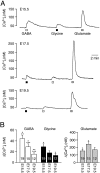

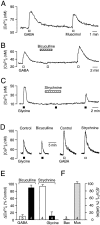

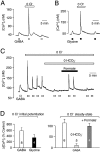

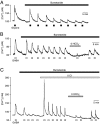
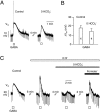

Similar articles
-
Astrocytes regulate developmental changes in the chloride ion gradient of embryonic rat ventral spinal cord neurons in culture.J Physiol. 1998 Jun 15;509 ( Pt 3)(Pt 3):847-58. doi: 10.1111/j.1469-7793.1998.847bm.x. J Physiol. 1998. PMID: 9596804 Free PMC article.
-
Contribution of Ca(2+)-permeable AMPA/KA receptors to glutamate-induced Ca(2+) rise in embryonic lumbar motoneurons in situ.J Neurophysiol. 2000 Jan;83(1):50-9. doi: 10.1152/jn.2000.83.1.50. J Neurophysiol. 2000. PMID: 10634852
-
Development of glycine- and GABA-gated currents in rat spinal motoneurons.J Neurophysiol. 1995 Jul;74(1):113-21. doi: 10.1152/jn.1995.74.1.113. J Neurophysiol. 1995. PMID: 7472315
-
GABA and glycine in the developing brain.J Physiol Sci. 2016 Sep;66(5):375-9. doi: 10.1007/s12576-016-0442-7. Epub 2016 Mar 7. J Physiol Sci. 2016. PMID: 26951057 Free PMC article. Review.
-
Gramicidin perforated patch recording and intracellular chloride activity in excitable cells.Prog Biophys Mol Biol. 1996;65(3):251-64. doi: 10.1016/s0079-6107(96)00013-2. Prog Biophys Mol Biol. 1996. PMID: 9062434 Review. No abstract available.
Cited by
-
A critical role of the strychnine-sensitive glycinergic system in spontaneous retinal waves of the developing rabbit.J Neurosci. 2001 Jul 15;21(14):5158-68. doi: 10.1523/JNEUROSCI.21-14-05158.2001. J Neurosci. 2001. PMID: 11438591 Free PMC article.
-
Dual personality of GABA/glycine-mediated depolarizations in immature spinal cord.Proc Natl Acad Sci U S A. 2007 Jul 3;104(27):11477-82. doi: 10.1073/pnas.0704832104. Epub 2007 Jun 25. Proc Natl Acad Sci U S A. 2007. PMID: 17592145 Free PMC article.
-
Increasing the frequency of spontaneous rhythmic activity disrupts pool-specific axon fasciculation and pathfinding of embryonic spinal motoneurons.J Neurosci. 2006 Dec 6;26(49):12769-80. doi: 10.1523/JNEUROSCI.4170-06.2006. J Neurosci. 2006. PMID: 17151280 Free PMC article.
-
Basis of changes in left-right coordination of rhythmic motor activity during development in the rat spinal cord.J Neurosci. 2002 Dec 1;22(23):10388-98. doi: 10.1523/JNEUROSCI.22-23-10388.2002. J Neurosci. 2002. PMID: 12451138 Free PMC article.
-
Glycinergic and GABAergic synaptic activity differentially regulate motoneuron survival and skeletal muscle innervation.J Neurosci. 2005 Feb 2;25(5):1249-59. doi: 10.1523/JNEUROSCI.1786-04.2005. J Neurosci. 2005. PMID: 15689563 Free PMC article.
References
-
- Ballanyi K. In vitro preparations. In: Windhorst U, Johansson H, editors. Modern techniques in neuroscience research. Springer; Heidelberg: 1999. pp. 307–327.
-
- Ballanyi K, Grafe P, Reddy MM, ten Bruggencate G. Different types of potassium transport linked to carbachol and γ-aminobutyric-acid actions in rat sympathetic neurons. Neuroscience. 1984;12:917–927. - PubMed
Publication types
MeSH terms
Substances
LinkOut - more resources
Full Text Sources
Miscellaneous
